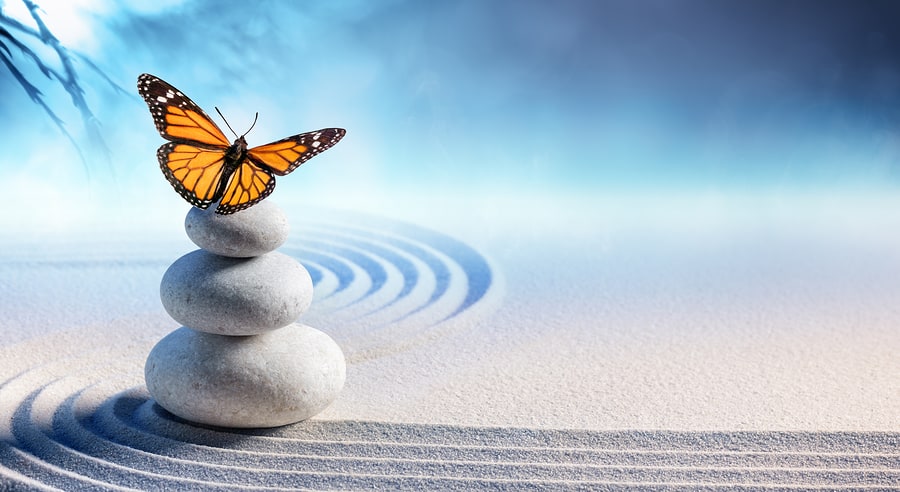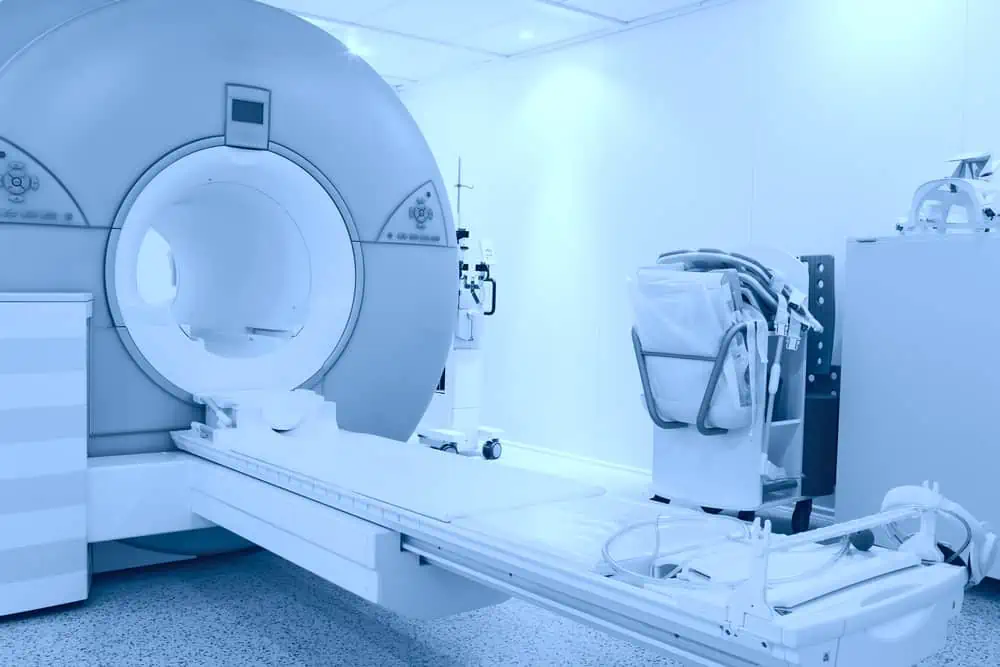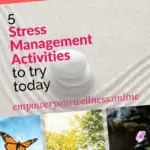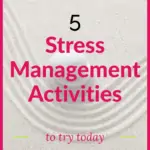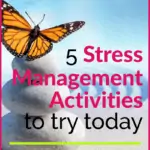This post may contain affiliate links. If you click through a link and make a purchase, I may receive a commission at no additional cost to you. As an Amazon Associate, I earn from qualifying purchases. Read the full disclosure here.
The struggle is real. We all know stress is bad for your health, especially chronic stress. These days it seems like there’s no way around it.
This isn’t yet another post telling you how bad stress is. This post is all about actionable steps you can use to help.
Here are 5 activities that help with anxiety and stress that you can try right now!
Activities that help with anxiety and stress
1. Yin yoga
Yoga is one of the number one natural ways to help manage stress. But here’s a new style to try: Yin Yoga.
I first tried Yin Yoga several years ago at my local studio. It’s a totally different type of yoga experience. I later became certified in Yin as part of my 500-hour teacher training.
Yin Yoga is a slower-paced style of yoga that involves gently moving into positions (can be supported with props) and holding for a more extended period of time, in some cases, up to 5 min.
Yin targets the plastic tissues of the body, such as ligaments, and can also have a positive effect on fascia mobility.
This study concluded that a 5-week yin practice “could be an easy and low-cost method of limiting negative health effects associated with high stress.”
Read more about yin and other styles of yoga for relaxation in this article.
Yin Yoga isn’t offered everywhere, but you can find free classes on YouTube with one of my favorite online yoga sources: Yoga with Kassandra.
2. Unplug from technology
Since the start of the pandemic, it seems like we’re all a little more reliant on digital connections.
After a few days of trying to get more done on the computer, I ended up with more fatigue, a headache, and fewer steps than I usually take in a day. And I’ll be honest; I didn’t particularly feel “less stressed.” It was more like “I feel super busy, but I’m not getting anything done.” The internet is a great way to waste time and have nothing to show for it.
It’s smart to know what’s going on in the world, but take a break from the 24-hour news cycle, and social media feeds.
Replace some of that time with other stress management activities that have a positive impact on your overall health and wellbeing.

3. Get fresh air
It’s incredible how many people I started to see out walking, jogging, etc. since the world shut down. Wouldn’t it be great if we could keep up that kind of activity and appreciation for fresh air when things start to normalize again?
There are numerous health benefits to something so simple as breathing fresh air. Being outdoors can help boost immunity, decrease feelings of anxiety and depression, and give you a natural dose of Vitamin D.
As movement during COVID-19 becomes more restrictive, getting fresh air becomes more challenging. If it’s not possible to get outside, at least open some windows and let in some fresh air and that refreshing “spring” smell (allergies and all).
4. Try meditation
I know what you’re thinking.
Here’s another person telling me to “just meditate.” Well, it’s not that easy!
You’re right. It’s not that easy.
It’s not easy for me either, but there have been times when I’ve felt better afterward, so it’s worth a shot, isn’t it? Anyone that has ever started a meditation practice may tell you it can be frustrating to calm your mind.
If you’re reading this during COVID-19, our mental health as a society isn’t exactly getting better. Meditation is something you can do for free and try right now.
Anyone can practice meditation. There is no fitness level or experience required.
Studies show that meditation can have a positive effect on anxiety, mental health, digestion, etc. You don’t have to strive for 10-20 minutes. Even 2-3 minutes consistently can have a positive impact. Just start with breathing exercises (we’ll get to how in the next section.)
I have the best luck with guided meditations. If I can relax and get into it, after a 10 minute guided meditation, I feel good, as if I’ve just woken up from a power nap. Now that’s something.
Aaptiv has guided mediation as part of its audio fitness offerings. There are also many free options on YouTube.
Recommended read: Body Awareness For Injury Prevention
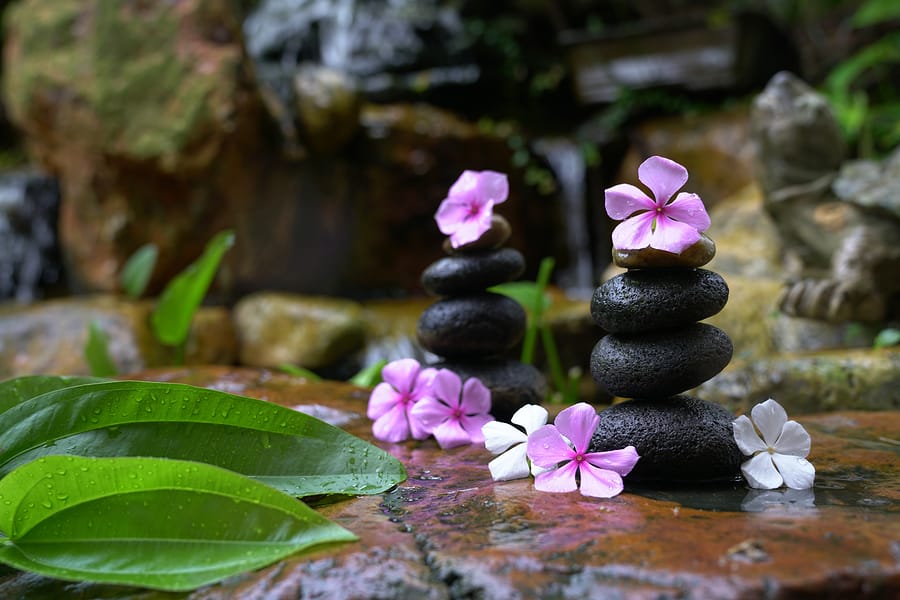
5. Breathing exercises & Pranayama techniques
Breathing techniques are a quick and easy way to “reset” the system.
Controlled deep breathing can elicit a relaxation response to decrease heart rate, blood pressure, and reduce the concentration of stress hormones circulating the body.
Your meditation practice can begin with something as easy as breathing exercises. It’s important to slow down and not be in a hurry.
Pranayama is a technique used in yoga to improve breath awareness and regulation of the breath to change the energy flow within the body.
Here are some deep breathing exercises to try:
Diaphragmatic breathing: aka belly breathing:
- Sit or lie down comfortably
- Place one hand on your chest and one hand on your abdomen
- Inhale deeply through your nose and feel your abdomen expand
- Exhale through pursed lips (like you’re blowing out candles) by using your abdominal muscles to push the air out.
- Repeat several cycles until you feel more relaxed.
To learn more about the role of the diaphragm, read The Skinny On Core Strength.
Box breathing:
- Inhale deeply through your nose for 4 counts
- Hold your breath for 4 counts
- Exhale as much air as you can through your mouth for 4 counts
- Hold your breath for 4 counts
- Repeat at least 4 cycles
4-7-8 breathing:
- Inhale deeply for 4 counts
- Hold your breath for 7 counts
- Exhale through your mouth for 8 counts
- Repeat for 4 cycles
You can adjust the cycles to what works for you, but the goal is to focus your attention on the breath and slow your breathing to relax the system as a whole.
You might be thinking, how many different ways are there to breathe? A lot.
Here are some additional resources for breathing exercises and types of Yoga breathing.
One of my favorite breathing techniques from yoga is Ujjayi breath, which uses a gentle constriction in the back of the throat during exhalation, producing a sound like rolling ocean waves.
For a much longer explanation, including dispelling yoga breathing myths, check out this article on Ujjayi breath.
I’ve found myself using this breathing technique even off the mat. It’s like listening to the “ocean” in a giant seashell kind of soothing.
This breathing technique has brought me some peace in a pinch.
Ready to decrease stress?
Try these easy and free stress management activities today to help naturally decrease the negative effects of stress and anxiety.
What are your go-to stress management activities? Leave a comment below!
Featured image credit: R_tavani / bigstockphoto.com
References
Daukantaitė D, Tellhed U, Maddux RE, Svensson T, Melander O. Five-week yin yoga-based interventions decreased plasma adrenomedullin and increased psychological health in stressed adults: A randomized controlled trial. PLoS One. 2018;13(7):e0200518. Published 2018 Jul 18. doi:10.1371/journal.pone.0200518
Zaccaro A, Piarulli A, Laurino M, et al. How Breath-Control Can Change Your Life: A Systematic Review on Psycho-Physiological Correlates of Slow Breathing. Front Hum Neurosci. 2018;12:353. Published 2018 Sep 7. doi:10.3389/fnhum.2018.00353

